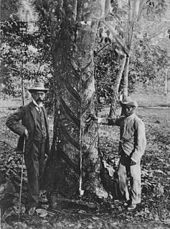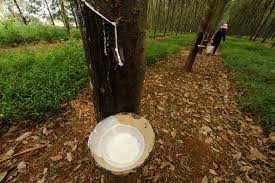
Background
Today, not many people
would know H. N. Ridley. As a Malaysian business and innovation historian, I had studied the development of Malaysian major industries. I noted, in each industry, there was a notable industry champion. Of all the Malaysian industries, plantation rubber had the most economic impact on British Malaya (Malaysia before independence in 1957), and the development of the rubber plantation industry can be attributed to one individual, namely H. N. Ridley.
Many historians would agree that the economic foundation of British Malaysia in late 1800s and early 1900s was built on the plantation rubber industry. When the motorcar industry was emerging in Europe and US there was a huge demand for rubber latex to produce tires. Then, the supply of rubber latex, which was tapped from wild rubber trees in the Amazon jungle in South America, was not enough to meet the need of the fast growing tire producing companies.Thus, efforts were made to produce rubber latex under plantations. British planters were already planting coffee plants in large estates in British Malaya and Ceylon.British Malaya and Ceylon had the suitable climate for the rubber trees found in the Amazon jungle. In 1876, the British government of India assisted Henry Wickham to buy 70,000 seeds (at 10 Pounds per 100 rubber seeds). He chartered a ship, SS Amazons, to export the rubber seeds, with the goodwill and co-operation of the Brazilian government, to Kew Gardens in London, where 2,800 germinated. Most of the germinated seeds were sent to Ceylon, and a few to Singapore and Java.
In 1888, H. N. Ridley came to Singapore and was appointed the Director of the Singapore Botanic Garden. During his tenure of twenty three years, H. N. Ridley became a fervent champion of the rubber plantation industry and earned him the nickname, “Mad Ridley”. There were many challenges facing the early plantation rubber industry in the late 1800s. One of them was convincing the local British and Chinese planters to switch from coffee bushes to rubber trees. Another was to extract rubber latex from the rubber trees without damaging them. Ridley spent many years promoting rubber trees as a commercial crop. He gave away rubber seeds when he met the coffee planters. Notable planters who shared his vision included Tan Chay Yan and the Kindersley brothers. These planters were the first group of planters who planted rubber trees on their estates. He also established a technique to harvest rubber latex without damaging the rubber trees.

By the early 1900s, the rubber plantation industry had significant areas planted with rubber trees. By 1910, British Malaya became an important rubber producer, riding on the rapid growth of the motorcar industry in Europe and US., and H. N. Ridley’s dream fulfilled. More important was that the rubber plantation industry opened vast areas in British Malaya where rubber trees were planted in large estates by British-owned companies. They obtained capital from the listing of their shares on the London Stock Exchange. Rubber trees were also planted by villagers in smallholdings. It seemed that everyone in British Malaya planted rubber trees, and every investor in London owned shares of rubber companies.
Lesson Learned
The emergence of the rubber plantation industry showed the need of commitment and efforts of an industry champion such as H. N. Ridley who believed in the potential of the rubber plantation industry. He also helped in solving the various technical problems facing the nascent rubber plantation industry. Many industries also had such industry champions.

British Malaya became a prominent producer of an important industrial material in the early 1900s. Now, Malaysia can again became an important producer of products that the world needs, but we need industry champions of the calibre of H. N. Ridley. He lived long enough to see the growth of the rubber industry when he passed away on 24th, October, 1956.
We hope new Malaysian industry champions will rise!!